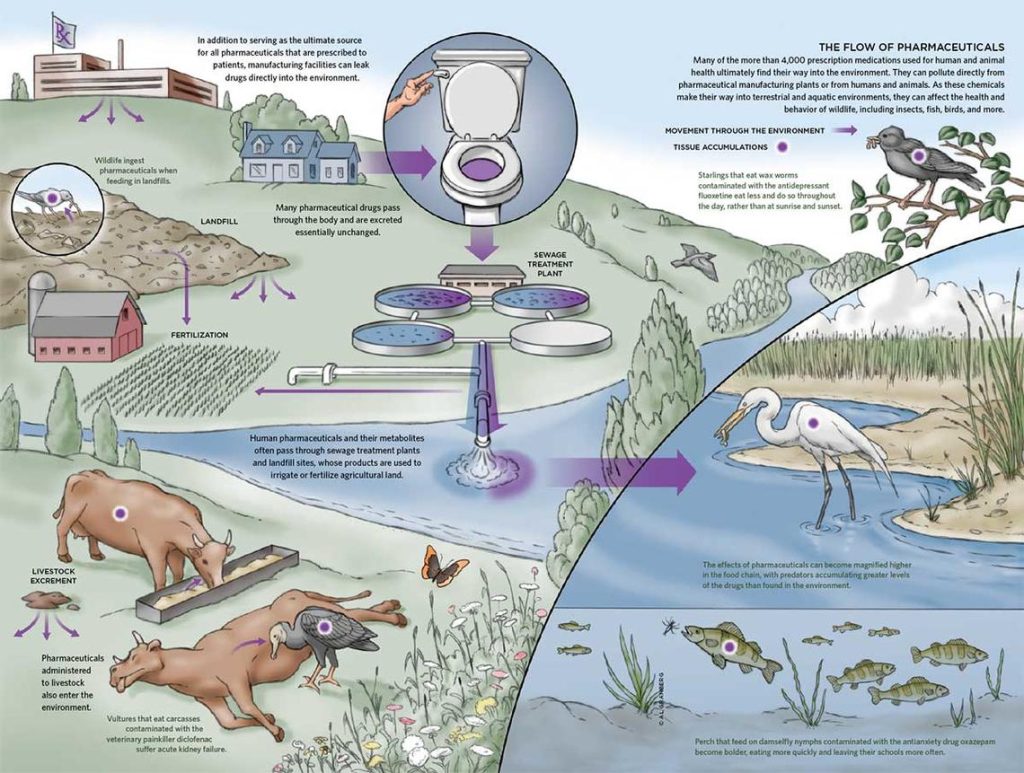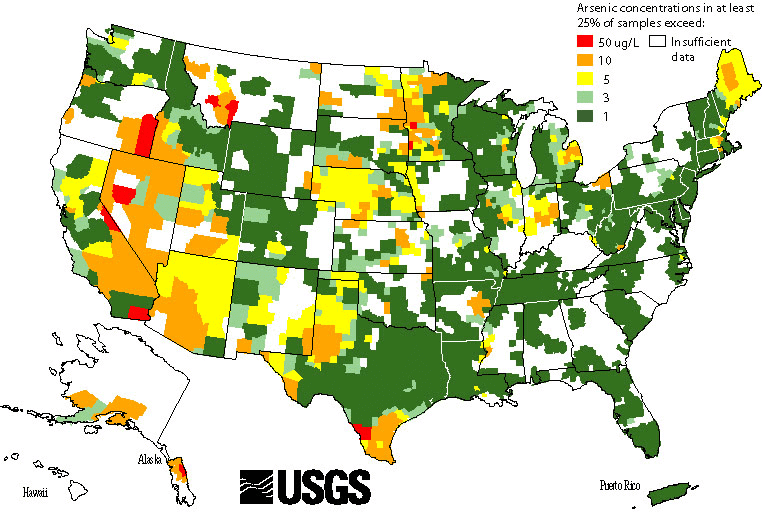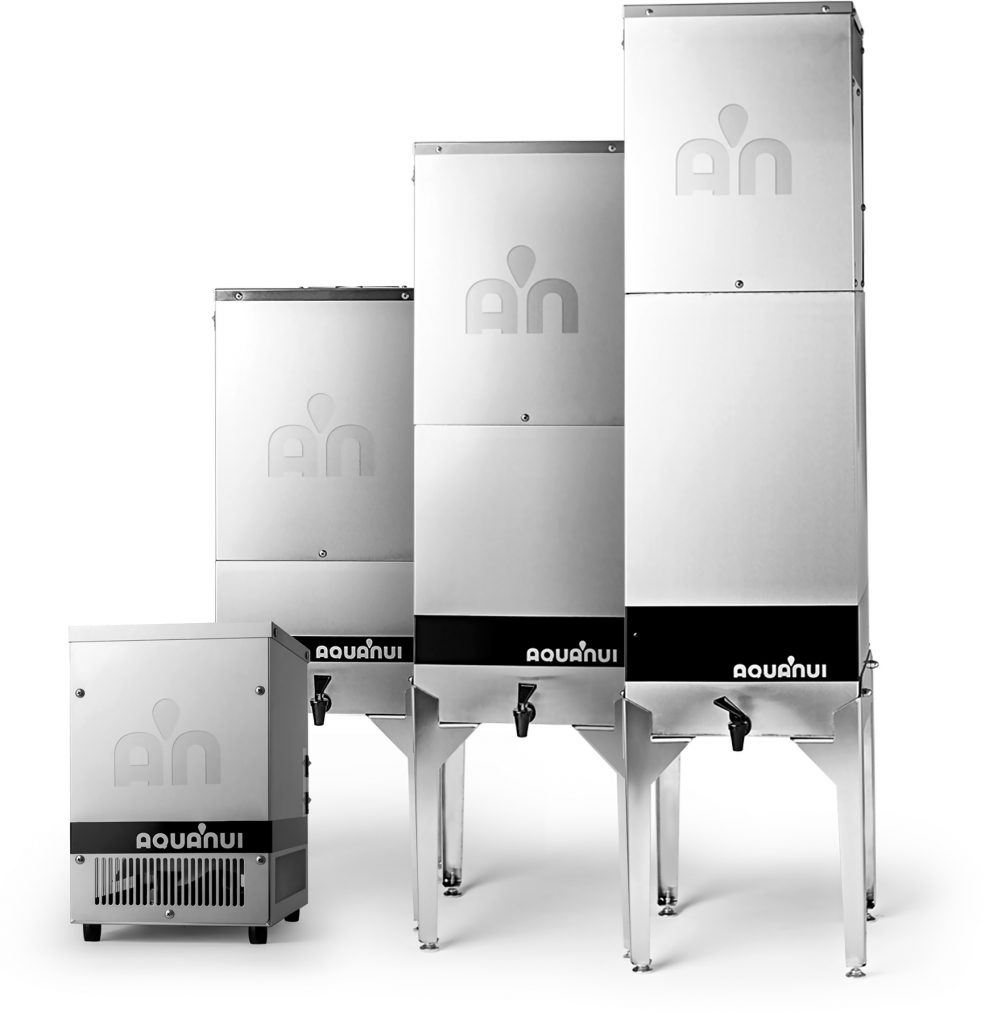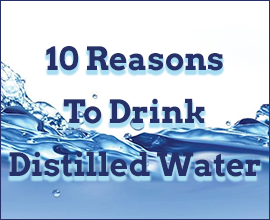Drinking distilled water is a fantastic way to support your overall health. You will enjoy how refreshing it is, which makes it easier to reach your hydration goals. Most importantly, however, you will be drinking pure water devoid of contaminants that can get into tap water or well water.
10. Nitrates / Nitrites
Nitrates in drinking water have become an increasingly alarming problem. Many towns and cities in farming areas have suffered the ill effects of excess nitrates in their water. Whether you are using well water or tap water, one must be mindful of the long-term impact of nitrates on the human body. “High levels can turn skin to a bluish or gray color and cause more serious health effects like weakness, excess heart rate, fatigue, and dizziness.” (Source: DHS Wisconsin). Nitrates can cause Blue Baby Syndrome, thyroid disease, cancer (particularly colorectal and pediatric), and birth defects. [Read more about nitrates in drinking water.]

Nitrates in drinking water limits: 10 mg/L
9. Lead
Lead in drinking water is usually caused by corrosion in lead pipes, faucets and fixtures. There is no safe level of lead and once it enters your body, it can’t be removed. Lead can cause the following health issues.
- Lower IQ
- Learning Disabilities
- Hyperactivity
- Reproductive Problems in Both Men and Women
- Central Nervous System Problems
- Impaired Hearing
- Impaired Formation and Function of Blood Cells
- Anemia
- Shorter Stature
- Seizures, Coma, and Even Death
Lead in drinking water limits: 15 micrograms per liter (µg/l)
The EPA has set a goal of zero MCLGs due to how toxic lead is even at low levels. [Read more about lead in drinking water.]
8. Chlorine / Chloramines
After chlorine was found to react to organic materials to form trihalomethanes which cause an increase in bladder, rectal, and colon cancer, water treatment plants have switched to a process of chloramination, which involves the addition of anhydrous or aqueous ammonia (NH3). More than 20% of the United States treats drinking water with chloramines. Chlorine is often used to kill bacteria and viruses. It can, however, react negatively with other substances to create a negative effect.
Chlorine in drinking water limits: 4 milligrams per liter (mg/L or 4 parts per million (ppm))
7. Bacteria, Viruses & Protozoa
There are many reasons why viruses or bacteria might find a home in your drinking water. Leaky pipes, failing or overloaded wastewater treatment, and improperly managed septic systems can all provide an opportunity for bacteria to find their way into your drinking water. Adenovirus, hepatitis, norovirus, rotavirus, and many more can all be waterborne illnesses that can cause anything from stomach pain, cramps, and diarrhea to death. Protozoa such as cryptosporidium and giardia can cause gas, diarrhea, nausea, dehydration, and vomiting. These bacteria, viruses, and protozoa do not always respond to chlorination alone. Don’t forget that pets can be affected by some of these illnesses as well, so providing your pet with distilled water is also essential! [Read more about distilled water for dogs, cats and other pets.]
6. Microplastics
Microplastics can be any tiny bits of plastic that break off or small beads of plastic used in self-care products like facial scrubs. These tiny plastics are everywhere, including air, soil, oceans, animals, and even human organs. Heating items is one way to get microplastics to come loose, like heating food in a microwave in a plastic container or putting hot water into a plastic baby bottle and shaking it. One way to avoid drinking microplastics is to use a water distiller. Another way is to stop buying bottled water, as plastics add to this problem.
5. Pharmaceuticals
Water treatment facilities do their best to disinfect water and to remove known contaminants, but what about all of the pharmaceuticals that end up in wastewater through urine or feces? What about all of the medications given to farm animals? “There is a growing concern about the occurrence of pharmaceuticals in water bodies and in drinking water. Pharmaceuticals get into the water supply via human excretion and by drugs being flushed down the toilet. You might think wastewater treatment plants would take care of the situation, but pharmaceuticals pass through water treatment.” (Source: USGS.gov). Since it’s a known issue but challenging to say at any given time or day if there are pharmaceuticals in your drinking water, distillation is the safest way to remove these types of contaminants.

Credit: Al Grandberg https://www.usgs.gov/media/images/pharmaceuticals-move-throughout-aquatic-environment
4. Arsenic
Arsenic is a real problem, particularly in private wells, but also in tap water. Arsenic is naturally occurring, but this odorless, tasteless element can cause cancer and skin lesions, and it is associated with diabetes and cardiovascular disease. Simply boiling water with arsenic in it will increase the concentration. Pure Water Distillers allow arsenic to be left behind in the boiling tank to be flushed away (not consumed) while the pure vapor is captured and condensed for drinking.

Arsenic in drinking water limits: 10 micrograms per liter (µg/L)
3. PFOA & PFOS
PFOAs have been known to cause cancer in animals in laboratory settings. PFOAs can also cause developmental delays, low birth weight, decreased fertility, reduce the immune system’s ability to fight infection, interfere with hormones, and increase cholesterol and obesity. PFOAs can be found in drinking water, soil, food, household products, dust, personal care products, biosolids, fire extinguisher foam, and more.
“Several states have groundwater quality regulations for PFOA. In West Virginia and Ohio, residents must be provided alternative drinking water when PFOA levels exceed 70 ng/L. Minnesota has adopted a Chronic Health Risk Limit of 300 ng/L for PFOA and PFOS in drinking water. In 2018, New Jersey recommended a health-based Maximum Contaminant Level (MCL) of 13 ng/L for PFOS, 14 ng/L for PFOA, and adopted an MCL for PFNA of 13 ng/L in drinking water.” (Source: California Water Board)
PFOAs in drinking water limits: No MCL for any PFAS chemicals. The EPA has established a non-enforceable health advisory level of 70 parts per trillion (ppt) for the sum of PFOA and PFOS.
2. Uranium
Many people don’t think about uranium in their drinking water, but it is another naturally occurring element that can find its way into your water.
Well owners have to ensure that their well has not become contaminated with uranium by frequently testing their wells. This element is toxic to the kidneys and can increase cancer risk. Unfortunately, it’s also possible that nitrate pollution may be triggering uranium to be released into groundwater. (Source: Chemical & Engineering News) Thankfully, a home water distillation system can remove uranium from drinking water, making it safe to consume.

Uranium in drinking water limits: 30 micrograms per liter (µg/L)
1. Take Control of Your Drinking Water
Protecting your health is your right. While you might assume that the water you drink is safe, it might not always be the case. There are accidents, natural contamination, pesticides, pharmaceuticals, pipes that burst, abandoned or improperly stored chemicals, and more. There are thousands of things that could affect the quality of your drinking water, but one individual action that would allow you to control your water quality; is owning a water distiller. Like the ones produced by Pure Water, a high-quality water distillation unit is the single best way to guarantee that the water you drink does not contain impurities that could make you sick now or in the future. Take charge of your health by only drinking pure vapor distilled water from your Pure Water Distiller. [View contaminant removal list]

